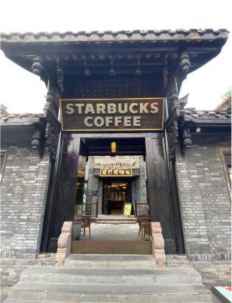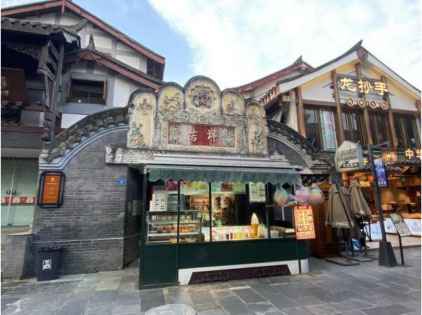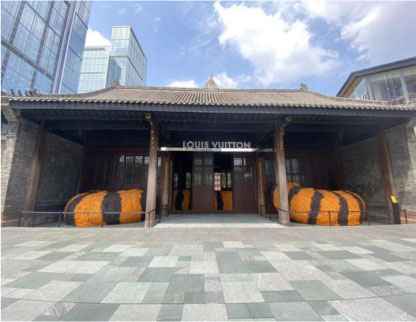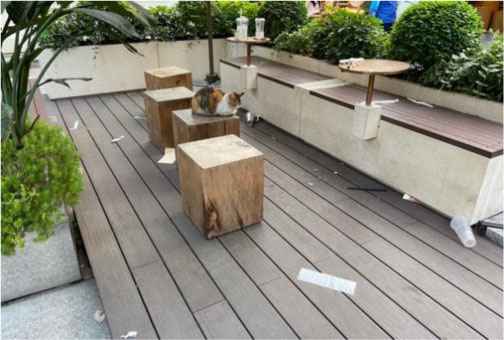Revised 26 January 2022
Accepted 21 November 2022
Available Online 10 January 2023
- DOI
- https://doi.org/10.55060/s.atssh.221230.029
- Keywords
- Ancient Chinese architecture
Urban homogenization
Spatial studies
Function transformation
Commercialism - Abstract
China's modernization is usually involved in the discussion of ancient Chinese architecture. The possibility of urban homogenization requires city planners to consider the function transformation of ancient Chinese architectures so that an individual city may maintain its unique identity. This article classifies ancient Chinese architecture into two categories according to initial service objects, and then discusses the function transformation of ancient Chinese architecture in modern times. Finally, it refers to the interactions between diverse groups in ancient Chinese architecture after the modern transformation with spatial studies. This article adopts two research methods: document analysis and case study analysis. The research results demonstrate that ancient Chinese architectural classification without a specific condition is indiscernible. Under the guise of heterogenization, the functional transformation of ancient architectures is usually accompanied by a commercial intention. Besides, architectural studies should extend to spatial studies with fluidity.
- Copyright
- © 2022 The Authors. Published by Athena International Publishing B.V.
- Open Access
- This is an open access article distributed under the CC BY-NC 4.0 license (https://creativecommons.org/licenses/by-nc/4.0/).
1. INTRODUCTION
Ancient Chinese architectures can be classified into two categories followed by their initial service objects such as living people, ancestors or deities. Thus, one type of ancient Chinese architecture is for the secular world and another focuses on religious practices. By contrast, some ancient Chinese architectures contain twofold functions. This article uses Daci Temple and Kuan and Zhai Alley, located in Chengdu, to explain this classification, which divided the types of ancient Chinese architectures into secular and religious. The previous discussion of ancient architecture in a city usually concentrated on reconstructing or protecting these buildings without discussing their specific adoptions with modern Chinese cities and human participation. So, this article explores human involvement in the space of these architectures. Functional transformation of ancient Chinese architectures is usually followed by market-driven intentions. Commercialism in these ancient sites manifests how the market applies heterogenization to achieve a commercial goal. Finally, this article views ancient Chinese architectures and their stakeholders from the perspective of space. The discussion in this part primarily focuses on the extension from architectural studies to spatial studies.
This article attempts to demonstrate how ancient Chinese architecture changes its traditional classification in different situations. Categorizing the function of ancient Chinese architecture in this dynamic way may encourage more detailed architectural research by placing each case in a specific context. Also, the relationship between the modern functional transformation of ancient Chinese architectures and commercialism can reflect the era of amusing ourselves to death. The extension from architectural studies to spatial studies demonstrates the importance of intersectionality and exploring architecture in a more comprehensive and holistic way.
2. CLASSIFICATION OF ANCIENT CHINESE ARCHITECTURE
There are generally two categories of ancient Chinese architecture according to initial functions: secular and religious architecture. After Confucius' re-explanation of ritual music based on secular ethics, Chinese art detached from pure mysticism and religious obsession, concentrating on the co-existence between the secular and heavenly worlds [1]. This ideology has continued and formed a Chinese artistic norm [2]. The nature of this norm implies the category of Chinese architectural function contains an indiscernible line and cannot simply apply dualism to judge them as either secular function or religious function. Thus, the classification in this article only indicates the tendency of each type in one architecture — this article uses Kuan and Zhai Alley and Daci Temple to clarify the classification.
2.1. Secular Architectures
Secular architectures usually serve to live people and dominate many ancient Chinese architectures. Kuan and Zhai Alley is inclined to a secular architectural group since this alley is the military station of soldiers from the Qing Dynasty after the Junggar rebellion. With the fall of the Qing Dynasty, this alley also serves residents from diverse social groups. Unlike Western architectures, which usually chase the vertical height and the close distance with heaven, traditional Chinese architectures are interested in expanding the horizontal area and exploring the depth in this area, transitioning the walking experience of visible space to abstract time [1]. This arrangement manifests the importance of secular architecture, which concentrates on people's demands.
According to William Hogarth, an artwork's design and aesthetic standard root in the creation purpose [3]. This implies that the successful demonstration of the creation purpose is one critical criterion for assessing an artwork. Because of the social ethics in Confucius' explanation of Chinese ritual practices, the intention of Chinese creation tends to stimulate people's optimism about secular life instead of pursuing religious purification [1]. Thus, following Hogarth's statement, one intention of Chinese art is to consider the optimistic secular life bonded with social relationships and ethics. The consequence is that Chinese art becomes an external demonstration of inner desire. Both Li and Sirén demonstrate one example of focusing on inner pleasure in architecture. They state that ancient Chinese architectures usually adopted decorative and winged eaves through losing certain practical functions [1,2]. The trade-off between aesthetics and practical functions shows the importance of secular life overweighting religious life to some extent. In that case, the dominant proportion of considering alive people in the architectural creation is reasonable, whether from Confucius' explanation or the following architectural designs.
2.2. Religious Architectures
Religious architectures are primarily for the dead, ancestors, and deities. Architectures of this type usually involve certain religious practices such as praying and worshipping. Thus, Daci Temple, a Buddhist temple found in Wei and Jin Dynasties, is a religious architecture.
According to Ronald Grimes, religious practices are classified in a relatively narrow term: rite, which is repetitive, systematic, and otherworldly [4]. One point in Grimes' argument is that rite is narrower because this term is directly related to specific religious purposes and refers to an assigned group. Hence, people usually think religious architectures, under the accepted agreement, such as a monastery, temple, and tomb, are simply for rites and pursuing religious beliefs. By contrast, in a broader context, Grimes argues that practices without religious context should also be discussed and defined as rituals. Grimes' summary of ritual characteristics suggests that one trait of ritual is collective. This collective nature extends the meaning of communal activities to personal life [4]. Because of the relative broader context of ritual, ritual practices become more diverse and can be applied in numerous conditions. Thus, some profane activities are also contained in the range of ritual practices.
Besides, Grimes' summary of ritual characteristics indicates the difficulty of delivering a fixed definition of ritual [4]. From his ritual family characteristics, an activity is not required to meet all features. A ritual combines several features. This combining method forms a flexible assessment to judge the ritual tendency of an activity. This flexibility generates a fluid classification rule from the perspective of ancient Chinese architecture, mainly including the modern transformation of architecture. For example, Daci Temple is regarded as a religious architecture traditionally. However, this temple also involves secular activities such as viewing flowers in the temple. In this case, Daci Temple is not simply for religion but also a public place where people can view flowers together. Thus, the rite in this temple extends to ritual. From the perspective of people who view flowers, the temple is more like a secular architecture since this temple is more for secular entertainment instead of worshipping the deities. Thus, Daci Temple locates in the overlap area between the secular and religious worlds in a holistic view.
3. FUNCTIONAL TRANSFORMATION IN MODERN TIMES
Today's Kuan and Zhai Alley has become a commercial street. Numerous catering brands, such as Starbucks, have settled there (Fig. 1). To suit the antique style of the alley, Starbucks here also adopts the traditional Chinese architectural form. Almost all stores and restaurants here follow the traditional architectural style so that the whole commercial street remains a united style.
As a famous tourist attraction in Chengdu, the alley is a medium to advocate traditional Chengdu folk culture, such as drinking tea. Some restaurants here also sell traditional Chengdu food to tourists. Since the houses in the alley are still private residences in the Republic of China, several private garages exist. However, these garages have become a place for merchants to sell food now (Fig. 2). Space reconstruction like this is common in Kuan and Zhai Alley. The ultimate intention of the reconstruction in this alley is to turn the private space into a public space with local traditional elements that can bring tourism and commercial values.
Daci Temple is usually combined with Sino-Ocean Taikoo Li, a shopping center adjacent to the temple, as a complex tourist attraction now. Although Taikoo Li embraces ancient Chinese architectures, it prefers to introduce international luxury brands and settle the stores in these traditional architectures (Fig. 3). For example, in Fig. 3 the architecture was Guangdong Hall, but now it has become Louis Vuitton Maison. Like Starbucks in Kuan and Zhai Alley, Louis Vuitton adopts the tiger elements since the opening year of this Louis Vuitton Maison is in the year of the tiger in the Chinese lunar calendar. Because the location of Daci Temple is nearby by both Taikoo Li and Chunxi Road commercial areas, a considerable number of tourists to Daci temple are not only for religious practices. Some of them are more like flaneurs. They have no specific religious belief and visit here just because Daci Temple is a famous tourist attraction. Some, whose primary purpose is to purchase, may stop by to visit the temple because the temple is adjacent to the main commercial area in Chengdu.
4. URBAN HOMOGENIZATION AND COMMERCIALISM OF ANCIENT CHINESE ARCHITECTURES
Urban homogenization means the demonstrations of diverse global cities tend to be similar because of economic motivation and accepted development tactics [5]. As one of the biggest cities in southwestern China, Chengdu also attempts to develop as an international city. This tendency is demonstrated by the city's proliferated skyscrapers and complex buildings and the increasing number of international companies and brands deciding to settle there. However, one usual cost of rapid urban development is the city's unique identity fading or urban homogenization. Unique identity here indicates local cultural memory or social context. Gentrification may be one reason for the loss of city identity because of demographic movement. In gentrification, the local people may be forced to leave by the economic pressure brought by the new class. Consequently, the accumulated cultural memory formed by the previous local people gradually disappears [6]. Although both examples mentioned in the article do not involve apparent gentrification, the process of losing cultural identity provides a perspective to consider homogenization. This perspective suggests the disappearance of people from the previous community in one location followed by the loss of their communal culture. The location is gradually assimilated through domination of the new society.

Starbucks outlet in Kuan and Zhai Alley (photo by the author).

A private garage has become a place to sell food (photo by the author).

Louis Vuitton Maison in Sino-Ocean Taikoo Li shopping center in Chengdu (photo by the author).
From this perspective, although the externality of the examples mentioned above attempts to maintain the ancient architectural style, the population movement has changed the initial cultural meaning in these places. Thus, preservation of the ancient architectures is not effective since these architectures have already lost their original meanings when the market-driven community occupies the area. In other words, the planners and developers will decide the orientation of heterogeneity according to their commercial benefits [6]. From Lefebvre's argument, the space without social context is dead and preserved as a cultural antique instead of alive culture. The only relic of this space acts as tourist consumption with the guise of cultural propaganda, which is not a reflection of actual life [7]. The adoption of ancient architecture is only a commercial gimmick. Therefore, the functional transformation of ancient Chinese architectures in these examples is accompanied by the intention of increased tourist revenue.
The commercialism of ancient Chinese architecture can be analogized to the fashion cycle, which may elicit the relationship between ancient Chinese architecture in modern times and commercial revenue. According to Deapati and Wikantari, the traditional conflict between architecture and fashion is that the rapid iteration brought by commercialized nature in fashion cannot apply to the architectural transformation. In other words, architectures hold a more static and unchangeable feature than fashion since the huge funding in architecture [8]. However, the barrier between architecture and fashion may be broken up following post-modernism. Deapati and Wikantari argue that one characteristic of post-modernism is that society begins to concentrate on consumer culture. One crucial intention of this society is the attention to consumption satisfaction physically and aesthetically. Selling is the designers' priority [8]. Therefore, the preservation and unification of architectural style in the two examples result from consumer culture. The conservation of Daci Temple and its combination with Taikoo Li forms a cultural-commercial area that effectively manifests Chengdu's history and modern development. This area is more attractive with more commercial potential than either a historical attraction or a shopping center. Even the first three categories of Taikoo Li's official site are for commercial activities instead of following the order of introducing the location history first. Besides, this combination is unsurprisingly successful because of the young Chinese' passion for traditional Chinese culture over the years. To peruse aesthetic pleasure, Kuan and Zhai Alley also reconstruct traditional architecture even though most of them are modern products. By adding local cultural elements such as food, tea culture, and Sichuan opera, the identity as a commercial street turns into the representation of local culture, being a method to attract curious tourists. Under these circumstances, the remaining ancient architectures in the initial designs seem like a means to avoid urban homogenization. By contrast, since the demographic movement of people in these two examples and the commercialism of these architectures, unique urban identity has become developers' tool to promote the reconstruction location that serves commercial benefits.
5. INTERACTION IN ANCIENT CHINESE ARCHITECTURES
According to Lefebvre, the concept of space is ambiguous, which is different from the definition of absolute space. The occupation of space is a daily manifestation. A material body, as a space, is also a producer of a space with its motions [9]. Lefebvre's rejection of absolute space reveals that the relationship between space and existing objects in this space is not static. The meanings of the space and the space producer are dynamic according to the space producer's motion. Therefore, producing a meaningful space is a mutual process between the space and the stakeholders. Jilly Traganou holds the same idea about the interaction between living bodies and space from an architectural perspective. She argues that the inner meaning of architecture changes over time. Stakeholders of this architecture hold a personal understanding of it. One tendency of contemporary architectural studies is the relationship between stakeholders and the architecture [10]. Therefore, the study of individual architecture extends to spatial studies. Since stakeholders can empower the meaning of architecture, they can also change the designer's initial intention of an architecture. Under this circumstance, this article will discuss the interaction between human beings and the space formed by architecture.
6. INTERACTION FROM TWO PERSPECTIVES
Traganou states that contemporary architectural studies incline to focus on a broader context with the idea of intersectionality [10]. Hence, the interaction between humans and architecture is not constrained by the scope of practical usage but by the new meanings brought by visitors. In the context of ancient Chinese architectures, the considerations of space at different and the same times provide both vertical and horizontal ideas to assess how human beings interact with ancient architectures.
6.1. Interaction From the Perspective of Different Times
The vertical idea indicates how the relationship between human beings and ancient architecture changed over time. For example, the initial relationship between humans and Daci Temple is set between religious believers and religious architecture. The meaning of the temple limits the scope of religious activities. Since the construction of nearby Taikoo Li in contemporary times change some visitors' identity, Daci Temple is not simply for Buddhists but also for more diverse groups. The diversity of its visitors promotes Daci Temple's multifunctional. Thus, the temple is more like an attraction. The modern connection between Taikoo Li and Daci Temple forms a new niche for religious believers and other flaneurs. The meaning and functional extensions also follow Traganou's idea of putting architecture in a broader urban culture [10].
6.2. Interaction From the Perspective of the Same Times
The horizontal one focuses on how people interact with space differently in the same period. For example, Starbucks in Kuan and Zhai Alley adopts a traditional Chinese architectural style to suit the whole artistic atmosphere in the alley. Thus, there is an aesthetic harmony created by human involvement. The meaning of the alley transforms from a private space for residents to a representation of local traditional culture. The architectural uniformity further emphasizes this contemporary meaning. By contrast, the harmony between humans and the built environment may also be broken. For example, tourists in the alley may throw rubbish at will (Fig. 4). According to Traganou, users in the space are the ultimate decision-makers of the meanings in a space [10]. The case in Fig. 4 explains Traganou's argument of how space for rest becomes a space occupied with rubbish. The space good transforms into space harm because of disharmony caused by human involvement. However, as mentioned above, the property of space is dynamic because of living bodies' motions [9]. For example, if someone cleans this resting place, harmony returns. Thus, the space good also returns.

Tourists throw rubbish at will in Kuan and Zhai Alley (photo by the author).
7. CONCLUSION
This article mainly discusses ancient Chinese architecture's classification and modern functional transformation. Under these two topics, this article explores urban homogenization and human interaction with a space from the perspective of ancient Chinese architecture. The research results reveal that classification of a specific ancient Chinese architecture is dynamic under different conditions. Contemporary architectural transformation in ancient Chinese architecture is usually accompanied by commercialism. By extending architectural studies to spatial studies, there are two perspectives to exploring human interaction with space. From the historical perspective, the relationship between human beings and space may change in a broader urban cultural context. In the same period, different groups also act differently. Human actions influence the space good and harm, and they can transform mutually through different human involvements. Because of the diversity of ancient Chinese architectures, the case studies in this article are still limited. More field research may be required in the future. The research may benefit architectural studies and inspire the exploration of tourism and commercialism in the post-COVID-19 eras.
REFERENCES
Cite This Article

TY - CONF AU - Ziting Liao PY - 2023 DA - 2023/01/10 TI - Function Transformation and Interaction of Ancient Chinese Architectures in Modern Times: Case Studies of Kuan and Zhai Alley and Daci Temple BT - Proceedings of the 4th International Conference on Architecture: Heritage, Traditions and Innovations (AHTI 2022) PB - Athena Publishing SP - 219 EP - 224 SN - 2949-8937 UR - https://doi.org/10.55060/s.atssh.221230.029 DO - https://doi.org/10.55060/s.atssh.221230.029 ID - Liao2023 ER -









